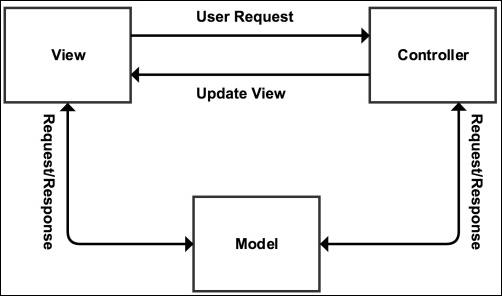Model View Controller (MVC) is a design pattern widely used in different programming languages. Most PHP frameworks use this design pattern. This pattern divides the application into three layers: Model, View, and Controller. Each one of these has separate tasks, and they are all interconnected. There are different visual representations for MVC, but an overall and simple representation can be seen in the following diagram:

Now, let's discuss each part of the MVC design pattern.
The model layer is the backbone of the application and handles the data logic. Mostly, it is considered that model is responsible for CRUD operations on a database, which may or may not be true. As we mentioned previously, model is responsible for the data logic, which means that data validation operations can also be performed here. In simple words, models provide an abstraction for the data. The remaining application layers don't know or care how and from where the data comes or how an operation is performed on data. It is the model's responsibility to take care of all data logic.
In today's complex framework structures, the overall MVC structure is changed, and not only do models handle data operations, but also, every other application logic is handled by models. The method followed is fat models and slim controllers, which means keep all the application logic in models and the controllers as clean as possible.
Views are what is visible to end users. All data related to this user and public is displayed in the views, so views can be called the visual representation of the models. Views need data to display. It asks for some specific data or action from the controller. Views do not know or want to know from where the controller gets this data; it just asks the controller to get it. Controller knows who to ask for this specific data and communicates with the specific model. It means that views do not have any direct link to models. However, in the earlier diagram, we linked model to view directly. This is because in the advanced systems nowadays, views can directly take data from models. For example, Magento controllers can't send data back to views. For the data (that is, to get data directly from the database) and/or to communicate with models, views communicate with blocks and helper classes. In modern practices, views can be connected to models directly.
Controllers respond to actions performed by a user in the views and respond to the view. For example, a user fills a form and submits it. Here, the controller comes in the middle and starts taking action on the submission of the form. Now, the controller will first check whether the user is allowed to make this request or not. Then, the controller will take the appropriate action, such as communicating with the model or any other operation. In a simple analogy, the controller is the middle man between views and models. As we mentioned before in the models section, controllers should be slim. So, mostly, controllers are only used to handle the requests and communicate with models and views. All kinds of data operations are performed in models.
The MVC design pattern's sole job is to separate the responsibilities of different parts in an application. So, models are used to manage the application data. Controllers are used to take actions on user inputs, and views are responsible for the visual representation of data. As we mentioned before, MVC separates the responsibilities of each part, so it does not matter whether it accesses the model from controllers or views; the only thing that matters is that views and controllers should not be used to perform operations on data, as it is the model's responsibility, and controllers should not be used to view any kind of data by the end user as this is the view's responsibility.



